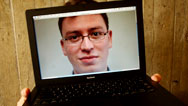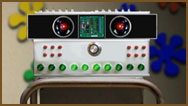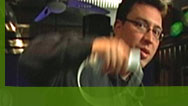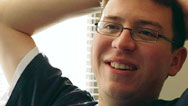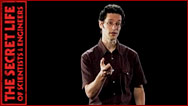
Profile: Luis von Ahn
A computer scientist finds novel ways to stop spammers and harness the brainpower of millions of people. Airing June 30, 2009 at 9 pm on PBS Aired June 30, 2009 on PBS
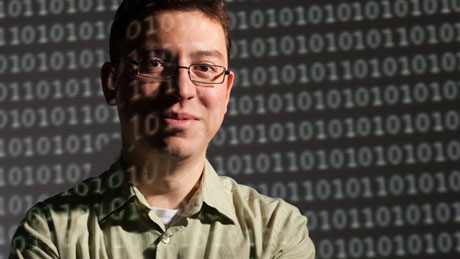
Program Description
Transcript
Profile: Luis Von Ahn
PBS Airdate: June 30, 2009
NEIL DeGRASSE TYSON (As Game Show Host): Welcome to Find that Robot! the show where our electronic bachelorette tries to guess which of our three mystery contestants is not human, because sometimes, like on the Internet, the difference is not obvious.
BATCHELORETTE COMPUTER: Bachelor Number One, what is your idea of the perfect date?
NEIL DeGRASSE TYSON (As Bachelor Number One): I'd take you to the finest restaurant, and I'd recite love poems to you while we sip expensive champagne.
BATCHELORETTE COMPUTER: Hmmm; I don't drink. Bachelor Number Two?
NEIL DeGRASSE TYSON (As Bachelor Number Two): We would take a long walk on the beach, watch a beautiful sunset, and I'd learn all about you by moonlight.
BATCHELORETTE COMPUTER: Great. Bachelor Number Three, what is your idea of the perfect date?
BACHELOR NUMBER THREE COMPUTER: The perfect date is June 23, 1912.
BATCHELORETTE COMPUTER: He's the one!
NEIL DeGRASSE TYSON (As Game Show Host): Oh, what a lovely couple.
(As himself) In this episode's profile, we'll meet a guy who not only invented a way for a computer to spot another a computer, but a way to do it that will actually help mankind.
Luis von Ahn may seem like a slacker. He loves watching television.
LUIS VON AHN: I watch a lot of TV. That's how I spend most of my time outside of work. If I had more time, I would fill it 100 percent with watching TV. Right now I'm watching Heroes, Dexter and Fringe. Weeds, I've been watching Weeds, as well.
NEIL DeGRASSE TYSON: When he's not watching TV, Luis is playing games.
LUIS VON AHN: I definitely play some games, like Nintendo D.S. or the Wii, and some computer games.
LAURA DABBISH (Luis von Ahn's Fiancee): Luis is the kind of person who gets a game, and he wants to beat the game, you know? Play it nonstop until he beats it.
NEIL DeGRASSE TYSON: Luis even calls everybody "dude."
LUIS VON AHN: That's a really good trick, if you don't know their name. Just like, "Dude." And then they're like, "Dude."
NEIL DeGRASSE TYSON: But Luis is no slacker. He's a hotshot Carnegie Mellon computer science professor. He drives a Porsche. And, at age 30, he's quickly raced to the top of his field. You may have read about him. And you've almost certainly used his cutting edge computer programs. So when Luis watches TV and plays games, he's actually doing serious research.
PETER LEE (Carnegie Mellon University): I don't think it's relaxation for him. In fact, I've never known him to relax. He is a sponge, just trying to understand what motivates this social animal, which is the masses.
NEIL DeGRASSE TYSON: And unbeknownst to you, you're probably already working for Luis: fighting spam, digitizing books and labeling images on the Web. You're part of Luis' master plan to mobilize the largest workforce in the history of mankind; the hundreds of millions of people who use the Internet.
LUIS VON AHN: One of the things that I'm trying to figure out is, what can we do with this many people? What can you do when you can get 100 million people working on the same thing? And I think we can do amazing things.
NEIL DeGRASSE TYSON: As for the source of his ideas, Luis is a human think tank.
LUIS VON AHN: I guess I'm a big pacer. I pace when I do most things. So yeah, when I'm trying to think or solve a problem, I pace around.
LAURA DABBISH: Any time he has a problem, and he's, sort of, ruminating over the problem, that's what he does. You would see him walk up and down that hallway 20 times a day. He can take a problem that seems impossible and just sort of see the solution, see through it.
LUIS VON AHN: I have multiple ideas per day, all the time. The vast majority of these are completely idiotic. Usually, I just sit on the idea for several months. And if I have not decided that it's idiotic, then it's...might be a good idea.
NEIL DeGRASSE TYSON: Luis' first big idea came when he and his adviser, Manuel Blum, were approached by Yahoo!.
MANUEL BLUM (Luis von Ahn's Ph.D. Advisor): The chief scientist at Yahoo! told us he had a problem.
NEIL DeGRASSE TYSON: The problem was spam, and it was clogging up Yahoo!. Spammers needed a vast number of email accounts to send their spam, and they were using automated computer programs to sign up for them.
LUIS VON AHN: Spammers were writing programs to obtain millions of Yahoo! email accounts every day, because they wanted to send spam.
NEIL DeGRASSE TYSON: Luis and Manuel needed a way to tell the difference between a well-meaning Yahoo! subscriber, and a malicious spam computer program.
LUIS VON AHN: We came up with this idea of trying to give a test to figure out whether it's a human or not.
It's got to be a computerized test, given to humans and computers. So the computer must be able to grade a test that it cannot pass. You know, it looks paradoxical.
NEIL DeGRASSE TYSON: What Luis and Manuel developed was a CAPTCHA, a secret password that people can read, but computers can't.
MANUEL BLUM: The computer can take some characters, and it can put them on a rubber sheet, and they can then stretch this sheet and pour paint on it, and change the looks of these characters, to the point where it can no longer see the original characters, and then can put it out there knowing that humans are still very good at being able to recognize this.
NEIL DeGRASSE TYSON: So using CAPTCHA, people could sign up for Yahoo! accounts, but automated spam programs could not. CAPTCHA has spread across the web. It's now used by most major websites.
PETER LEE: CAPTCHA has had this amazing impact. There are fairly good estimates that more than 750-million different people in the world have solved at least one CAPTCHA.
NEIL DeGRASSE TYSON: Luis' resourcefulness and his quest for efficiency go back as far as he can remember, as a boy growing up in Guatemala, where his family owned a candy factory.
LUIS VON AHN: I think growing up in a candy factory has influenced me. It's quite a complex process, the machines of making the candy and wrapping it and everything. I always wondered how all of those machines worked.
NEIL DeGRASSE TYSON: At the age of seven, Luis even built his own machine, to do his homework faster.
LUIS VON AHN: I was taking a penmanship class. The assignments were to draw a lot of ovals, like, a gazillion ovals. And that was really boring. So what I did, is I put, like, five pens together. I was just using that one thing with the five pens and it was going five times faster. Of course, I got caught. But it was great while it lasted—doing my homework in 20 minutes as opposed to an hour and a half.
NEIL DeGRASSE TYSON: Twenty years later, Luis applied this same kind of efficiency to the time wasted typing in CAPTCHAs.
LUIS VON AHN: I started feeling bad, because each time you type a CAPTCHA—you know, the squiggly characters—essentially, you waste 10 seconds of your time. And if you multiply that by 200 million, you get that humanity as a whole is wasting, like,
500,000 hours every day, typing these annoying CAPTCHAs. I started thinking, is there a way in which we could use this human effort for something that's good for humanity? Can we make good use of those 10 seconds of your time?
NEIL DeGRASSE TYSON: Luis struggled with this question. And then he got involved with an even bigger project: putting all the old books in the world onto the Internet.
LUIS VON AHN: There's a lot of projects out there trying to digitize books; Google has one, the Internet Archive has another one.
NEIL DeGRASSE TYSON: But there's a problem. Many of the books are old and faded, so when the computers scan them, they don't recognize many of the words.
LUIS VON AHN: For things that were written before 1900, between 30 percent and 40 percent of the words, the computer is going to decipher wrong.
MANUEL BLUM: They were written at a time when the type didn't line up always nicely, and what remnants we have of it are smudged.
NEIL DeGRASSE TYSON: Luis's solution was to take these hard to read words from old books and use them as CAPTCHAs.
But this raised a new problem, the computer would now present a word that it could not read in the first place.
MANUEL BLUM: The computer didn't know what the answer was. How is it to be able to tell what the right answer is?
NEIL DeGRASSE TYSON: Luis found a solution: to combine the word from an old book with a traditional CAPTCHA generated by the computer.
MANUEL BLUM: We'll give two tests, one that we know the answer to, one that we don't. And if the person can solve the one that we know the answer to, then we'll assume they can solve the one that we don't.
NEIL DeGRASSE TYSON: They called it reCAPTCHA. Now, every time you type a CAPTCHA, you may very well be working for Luis, transcribing an old book.
PETER LEE: Today, on the order of 125 to 150 books per day are being digitized because of reCAPTCHA. It's an amazing thing.
NEIL DeGRASSE TYSON: And it's not just books. ReCAPTCHA is also transcribing the entire back archive of The New York Times.
LUIS VON AHN: The New York Times has this huge archive of 130 years of newspaper archived there. And we've done, maybe, about 20 years so far of The New York Times in the last few months. And I believe we're going to be done next year, by just having people do a word at a time.
NEIL DeGRASSE TYSON: With CAPTCHA and reCAPTCHA under his belt, Luis was a hot commodity when he graduated with his Ph.D. from Carnegie Mellon.
PETER LEE: He became this, kind of, sensation. People immediately understood that there was something very new here.
LUIS VON AHN: I had offers from Microsoft and Yahoo! and all kinds of companies. For the Microsoft offer, they even had Bill Gates call me.
NEIL DeGRASSE TYSON: But Luis wanted to become a professor.
LUIS VON AHN: I did turn my back on a lot of money. But in the end, I decided that I liked the academic job better.
NEIL DeGRASSE TYSON: Just days after taking a teaching job at Carnegie Mellon, Luis won the half-million dollar MacArthur Fellowship.
LUIS VON AHN: When I found out that I had won the MacArthur Fellowship, I had been a professor at Carnegie Mellon for a week. I probably shouldn't be saying this on TV, but I stopped worrying about tenure. Please give me tenure.
NEIL DeGRASSE TYSON: And it's not just the genius grant that may help Luis get tenure.
PETER LEE: Luis von Ahn is one of our very best teachers. In fact, last year he won one of the top awards for teaching here at Carnegie Mellon.
LUIS VON AHN: So my philosophy for teaching is, make it interesting or fun or just keep them engaged. That's the most important thing. Secondary to that is teaching them something.
On Screen Text: Okay, wait a minute. Rewind, please.
BACHELOR NUMBER THREE COMPUTER: "The perfect date is June 23, 1912."
What's so special about June 23, 1912? You tell us. Go to pbs.org.
Broadcast Credits
Profile: Luis von Ahn
- Edited by
- Joshua Baron
- Produced by
- Joshua Seftel and Jason Cavanagh
- Directed by
- Joshua Seftel
NOVA scienceNOW
- Executive Producer
- Samuel Fine
- Executive Editor
- Neil deGrasse Tyson
- Senior Series Producer
- Vincent Liota
- Senior Producer
- Julia Cort
- Supervising Producers
- Stephen Sweigart
Joey David Jovanovich - Senior Editor and Colorist
- David Chmura
- Senior Researcher
- Sharon Kay
- Associate Producer
- Fran Laks
- Assistant Editor
- Tung-Jen (Sunny) Chiang
- Graphic Design
- Brian Edgerton
- Compositor & Animator
- Yunsik Noh
- Music
- Rob Morsberger
- Sound Mix
- Bill Cavanaugh, RazorMix, Inc.
- Assistant to Neil deGrasse Tyson
- Elizabeth Stachow
- NOVA scienceNOW Series Animation
- Edgeworx
- Associate Producers
- Julie Crawford
Jonathan Loewald
Richard Marnell
Laura Willcox - Camera
- Austin de Besche
Brian Dowley
Robin Hirsh
Stephen Kazmierski
Rob Lyall - Sound Recordists
- John Cameron
James Lindsey
Len Schmitz
Chris Strollo - Animation and Graphics
- Anthony Kraus
Sputnik Animation
James LaPlante
Dan Nutu - Researchers
- Ethan Herberman
Eric Olson - Archival Material
- AP Worldwide Photos
BBC Motion Gallery
CNN Image Source
Corbis
The Frederick News-Post and Randall Family, LLC
Getty Images
Josh Landis
National Science Foundation
NASA
Prelinger Internet Archives
The San Diego Union-Tribune
Schenectady Museum & Suits-Bueche Planetarium
Steven Snyder
WTC: The First 24 Hours, Producers; Etienne Sauret & David Carrara - Special Thanks
- Jason Bannan, FBI microbiologist
Carnegie Mellon University
Dave and Busters
Gemological Institute of America
Justin Goger Malo
George Gray, Gray Jewelers
Susan Hrishenko
Northern Arizona University
David Rasko
Sandia National Laboratories
University of Maryland School of Medicine - Neil deGrasse Tyson
- is director of the Hayden Planetarium in the Rose Center for Earth and Space at the American Museum of Natural History.
- NOVA Series Graphics
- yU + co.
- NOVA Theme Music
- Walter Werzowa
John Luker
Musikvergnuegen, Inc. - Additional NOVA Theme Music
- Ray Loring
Rob Morsberger - Post Production Online Editor
- Spencer Gentry
- Closed Captioning
- The Caption Center
- NOVA Administrator
- Mykim Dang
- Publicity
- Carole McFall
Eileen Campion
Victoria Louie
Karinna Sjo-Gaber
Karen Laverty - Marketing
- Steve Sears
- Researcher
- Kate Becker
- Senior Researcher
- Gaia Remerowski
- Production Coordinator
- Linda Callahan
- Paralegal
- Sarah Erlandson
- Talent Relations
- Scott Kardel, Esq.
Janice Flood - Legal Counsel
- Susan Rosen
- Production Assistant
- Ryan Murdock
- Post Production Assistant
- Darcy Forlenza
- Associate Producer, Post Production
- Patrick Carey
- Post Production Supervisor
- Regina O'Toole
- Post Production Editors
- Rebecca Nieto
Jason York - Post Production Manager
- Nathan Gunner
- Compliance Manager
- Linzy Emery
- Development Producer
- Pamela Rosenstein
- Business Manager
- Joseph P. Tracy
- Senior Producer and Project Director
- Lisa Mirowitz
- Coordinating Producer
- Laurie Cahalane
- Senior Science Editor
- Evan Hadingham
- Senior Series Producer
- Melanie Wallace
- Managing Director
- Alan Ritsko
- Senior Executive Producer
- Paula S. Apsell
This material is based upon work supported by the National Science Foundation under Grant No. 0638931. Any opinions, findings, and conclusions or recommendations expressed in this material are those of the author(s) and do not necessarily reflect the views of the National Science Foundation.
NOVA scienceNOW is a trademark of the WGBH Educational Foundation
NOVA scienceNOW is produced for WGBH/Boston by NOVA
© 2009 WGBH Educational Foundation
All rights reserved
- Image credit: (Luis von Ahn) Courtesy Carnegie Mellon University
Participants
- Manuel Blum
- Luis' PhD Advisor www.cs.cmu.edu/~mblum/
- Laura Dabbish
- Luis' fiancee www.cs.cmu.edu/~dabbish/
- Peter Lee
- Carnegie Mellon University Computer Science Department Head www.cs.cmu.edu/~petel/bio.html
- Luis Von Ahn
- Carnegie Mellon University www.cs.cmu.edu/~biglou/
Preview
Full Program | 11:03
Full program available for streaming through
Watch Online
Full program available
Soon

